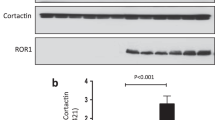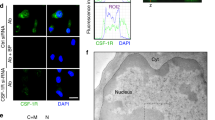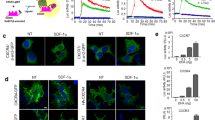Abstract
CXCR5 is a serpentine receptor implicated in cell migration in lymphocytes and differentiation in leukocytes. It causes MAPK pathway activation and has known membrane partners for signaling. CXCR5 mRNA is reportedly expressed in neutrophils following isolation, but its role in this cellular context is unknown. CXCR5 is also expressed in HL-60 cells, a human acute myeloid leukemia line, following treatment with all-trans retinoic acid, which induces differentiation toward a neutrophil-like state. CXCR5 is necessary for this process; differentiation was crippled in CXCR5 knockout cells and enhanced in cells ectopically expressing it. Since CXCR5 has various membrane protein partners, we investigated whether CXCR5-driven all-trans retinoic acid-induced differentiation depends on its association with such partners. Pursuing this, we generated HL-60 cells overexpressing the protein. We found that CXCR5 drove migration toward its ligand, CXCL13, and probed for interactions with several candidates using flow cytometry-based Förster resonance energy transfer. Surprisingly, we did not detect interactions with any candidates, including three reported in other cellular contexts. Additionally, we observed no significant changes in all-trans retinoic acid-induced differentiation; this may be due to the stoichiometry of CXCR5 and partner receptors or CXCL13. The anticipated membrane partnerings were surprisingly apparently unnecessary for downstream CXCR5 signaling and all-trans retinoic acid-induced differentiation.






Similar content being viewed by others
Change history
21 September 2020
There is a typographical error in the primer sequence published in this article.
References
Ansel KM, Ngo VN, Hyman PL, Luther SA, Förster R, Sedgwlck JD, Browning JL, Upp M, Cyster JG (2000) A chemokine-driven positive feedback loop organizes lymphoid follicles. Nature 406:309–314. https://doi.org/10.1038/35018581
Atanasova M, Whitty A (2012) Understanding cytokine and growth factor receptor activation mechanisms. Crit Rev Biochem Mol Biol 47:502–530. https://doi.org/10.3109/10409238.2012.729561
Barroso R, Martínez Muñoz L, Barrondo S, Vega B, Holgado BL, Lucas P, Baíllo A, Sallés J, Rodríguez-Frade JM, Mellado M (2012) EBI2 regulates CXCL13-mediated responses by heterodimerization with CXCR5. FASEB J 26:4841–4854. https://doi.org/10.1096/fj.12-208876
Bateman A, Martin MJ, O’Donovan C, Magrane M, Alpi E, Antunes R, Bely B, et al. (2017) UniProt: the universal protein knowledgebase. Nucleic Acids Res 45:D158–D169. https://doi.org/10.1093/nar/gkw1099
Battle TE, Levine RA, Yen A (2000) Retinoic acid-induced blr1 expression promotes ERK2 activation and cell differentiation in HL-60 cells. Exp Cell Res 254:287–298. https://doi.org/10.1006/excr.1999.4766
Bénézech C, Luu NT, Walker JA, Kruglov AA, Loo Y, Nakamura K, Zhang Y, Nayar S, Jones LH, Flores-Langarica A, McIntosh A, Marshall J, Barone F, Besra G, Miles K, Allen JE, Gray M, Kollias G, Cunningham AF, Withers DR, Toellner KM, Jones ND, Veldhoen M, Nedospasov SA, McKenzie ANJ, Caamaño JH (2015) Inflammation-induced formation of fat-associated lymphoid clusters. Nat Immunol 16:819–828. https://doi.org/10.1038/ni.3215
Breitfeld D, Ohl L, Kremmer E, Ellwart J, Sallusto F, Lipp M, Förster R (2000) Follicular B helper T cells express CXC chemokine receptor 5, localize to B cell follicles, and support immunoglobulin production. J Exp Med 192:1545–1552. https://doi.org/10.1084/jem.192.11.1545
Breitman TR, Selonick SE, Collins SJ (1980) Induction of differentiation of the human promyelocytic leukemia cell line (HL-60) by retinoic acid. Proc Natl Acad Sci U S A 77:2936–2940. https://doi.org/10.1073/pnas.77.5.2936
Bunaciu RP, Jensen HA, MacDonald RJ, LaTocha DH, Varner JD, Yen A (2015) 6-Formylindolo(3,2-b)carbazole (FICZ) modulates the signalsome responsible for RA-induced differentiation of HL-60 myeloblastic leukemia cells. PLoS One 10:e0135668. https://doi.org/10.1371/journal.pone.0135668
Congleton J, MacDonald R, Yen A (2012) Src inhibitors, PP2 and dasatinib, increase retinoic acid-induced association of Lyn and c-Raf (S259) and enhance MAPK-dependent differentiation of myeloid leukemia cells. Leukemia 26:1180–1188. https://doi.org/10.1038/leu.2011.390
Dobner T, Wolf I, Emrich T, Lipp M (1992) Differentiation-specific expression of a novel G protein-coupled receptor from Burkitt’s lymphoma. Eur J Immunol 22:2795–2799. https://doi.org/10.1002/eji.1830221107
Ebert LM, Schaerli P, Moser B (2005) Chemokine-mediated control of T cell traffic in lymphoid and peripheral tissues. Mol Immunol 42:799–809. https://doi.org/10.1016/j.molimm.2004.06.040
El-Haibi CP, Sharma P, Singh R, Gupta P, Taub DD, Singh S, Lillard JW (2013) Differential G protein subunit expression by prostate cancer cells and their interaction with CXCR5. Mol Cancer 12:64. https://doi.org/10.1186/1476-4598-12-64
Förster R, Mattis AE, Kremmer E, Wolf E, Brem G, Lipp M (1996) A putative chemokine receptor, BLR1, directs B cell migration to defined lymphoid organs and specific anatomic compartments of the spleen. Cell 87:1037–1047. https://doi.org/10.1016/S0092-8674(00)81798-5
Förster T (1948) Intermolecular energy transference and fluorescence. Ann Phys 2:55–75
Hickstein DD, Back AL, Collins SJ (1989) Regulation of expression of the CD11b and CD18 subunits of the neutrophil adherence receptor during human myeloid differentiation. J Biol Chem 264:21812–21817
Kanbe K, Shimizu N, Soda Y, Takagishi K, Hoshino H (1999) A CXC chemokine receptor, CXCR5/BLR1, is a novel and specific coreceptor for human immunodeficiency virus type 2. Virology 265:264–273. https://doi.org/10.1006/viro.1999.0036
Kim CH, Lim HW, Kim JR, Rott L, Hillsamer P, Butcher EC (2004) Unique gene expression program of human germinal center T helper cells. Blood 104:1952–1960. https://doi.org/10.1182/blood-2004-03-1206
King M, Poya H, Rao J, Natarajan S, Butch AW, Aziz N, Kok S, Chang MH, Lyons JM, Ault K, Kelly KA (2009) CXCL13 expression in chlamydia trachomatis infection of the female reproductive tract. Drugs Today (Barc) 45(Suppl B):125–134
Kontani K, Nishina H, Ohoka Y, Takahashi K, Katada T (1993) NAD glycohydrolase specifically induced by retinoic acid in human leukemic HL-60 cells. Identification of the NAD glycohydrolase as leukocyte cell surface antigen CD38. J Biol Chem 268:16895–16898
Lamkin TJ, Chin V, Varvayanis S, Smith JL, Sramkoski RM, Jacobberger JW, Yen A (2006) Retinoic acid-induced CD38 expression in HL-60 myeloblastic leukemia cells regulates cell differentiation or viability depending on expression levels. J Cell Biochem 97:1328–1338. https://doi.org/10.1002/jcb.20745
Lee BP-L, Chen W, Shi H, Der SD, Förster R, Zhang L (2006) CXCR5/CXCL13 interaction is important for double-negative regulatory T cell homing to cardiac allografts. J Immunol 176:5276–1583
Legler DF, Loetscher M, Roos RS, Clark-Lewis I, Baggiolini M, Moser B (1998) B cell-attracting chemokine 1, a human CXC chemokine expressed in lymphoid tissues, selectively attracts B lymphocytes via BLR1/CXCR5. J Exp Med 187:655–660. https://doi.org/10.1084/jem.187.4.655
MacDonald RJ, Shrimp JH, Jiang H, Zhang L, Lin H, Yen A (2017) Probing the requirement for CD38 in retinoic acid-induced HL-60 cell differentiation with a small molecule dimerizer and genetic knockout. Sci Rep 7:17406. https://doi.org/10.1038/s41598-017-17720-4
Marra CM, Tantalo LC, Sahi SK, Maxwell CL, Lukehart SA (2010) CXCL13 as a cerebrospinal fluid marker for neurosyphilis in HIV-infected patients with syphilis. Sex Transm Dis 37:283–287. https://doi.org/10.1097/OLQ.0b013e3181d877a1
Moser B (2015) CXCR5, the defining marker for follicular B helper T (TFH) cells. Front Immunol 6:296. https://doi.org/10.3389/fimmu.2015.00296
Müller G, Lipp M (2001) Signal transduction by the chemokine receptor CXCR5: structural requirements for G protein activation analyzed by chimeric CXCR1/CXCR5 molecules. Biol Chem 382:1387–1397. https://doi.org/10.1515/BC.2001.171
Nakashima Y, Isomoto H, Matsushima K, Yoshida A, Nakayama T, Nakayama M, Hisatsune J, Ichikawa T, Takeshima F, Hayashi T, Nakao K, Hirayama T, Kohno S (2011) Enhanced expression of CXCL13 in human helicobacter pylori-associated gastritis. Dig Dis Sci 56:2887–2894. https://doi.org/10.1007/s10620-011-1717-8
Onfroy L, Galandrin S, Pontier SM, Seguelas M-H, N’Guyen D, Sénard J-M, Galés C (2017) G protein stoichiometry dictates biased agonism through distinct receptor-G protein partitioning. Sci Rep 7:7885. https://doi.org/10.1038/s41598-017-07392-5
Patel L, Charlton SJ, Chambers JK, Macphee CH (2001) Expression and functional analysis of chemokine receptors in human peripheral blood leukocyte populations. Cytokine 14:27–36. https://doi.org/10.1006/cyto.2000.0851
Platko JD, Forbes ME, Varvayanis S, Williams MN, Brooks SC, Cherington V, Yen A (1998) Polyoma middle T antigen in HL-60 cells accelerates hematopoietic myeloid and monocytic cell differentiation. Exp Cell Res 238:42–50. https://doi.org/10.1006/excr.1997.3782
Rupprecht TA, Kirschning CJ, Popp B, Kastenbauer S, Fingerle V, Pfister HW, Koedel U (2007) Borrelia garinii induces CXCL13 production in human monocytes through toll-like receptor 2. Infect Immun 75:4351–4356. https://doi.org/10.1128/IAI.01642-06
Schaerli P, Willimann K, Lang AB, Lipp M, Loetscher P, Moser B (2000) CXC chemokine receptor 5 expression defines follicular homing T cells with B cell helper function. J Exp Med 192:1553–1562. https://doi.org/10.1084/jem.192.11.1553
Schmidt C, Plate A, Angele B, Pfister H-W, Wick M, Koedel U, Rupprecht TA (2011) A prospective study on the role of CXCL13 in Lyme neuroborreliosis. Neurology 76:1051–1058. https://doi.org/10.1212/WNL.0b013e318211c39a
Shen M, Yen A (2008) c-Cbl interacts with CD38 and promotes retinoic acid-induced differentiation and G0 arrest of human myeloblastic leukemia cells. Cancer Res 68:8761–8769. https://doi.org/10.1158/0008-5472.CAN-08-1058
Shrestha D, Jenei A, Nagy P, Vereb G, Szöllősi J (2015) Understanding FRET as a research tool for cellular studies. Int J Mol Sci 16:6718–6756. https://doi.org/10.3390/ijms16046718
Suto H, Katakai T, Sugai M, Kinashi T, Shimizu A (2009) CXCL13 production by an established lymph node stromal cell line via lymphotoxin-beta receptor engagement involves the cooperation of multiple signaling pathways. Int Immunol 21:467–476. https://doi.org/10.1093/intimm/dxp014
Swaminathan G, Tsygankov AY (2006) The Cbl family proteins: ring leaders in regulation of cell signaling. J Cell Physiol 209:21–43. https://doi.org/10.1002/jcp.20694
Traverse S, Gomez N, Paterson H, Marshall C, Cohen P (1992) Sustained activation of the mitogen-activated protein (MAP) kinase cascade may be required for differentiation of PC12 cells. Comparison of the effects of nerve growth factor and epidermal growth factor. Biochem J 288(Pt 2):351–355. https://doi.org/10.1042/BJ2880351
Wang J, Yen A (2004) A novel retinoic acid-responsive element regulates retinoic acid-induced BLR1 expression. Mol Cell Biol 24:2423–2443. https://doi.org/10.1128/MCB.24.6.2423-2443.2004
Wang J, Yen A (2008) A MAPK-positive feedback mechanism for BLR1 signaling propels retinoic acid-triggered differentiation and cell cycle arrest. J Biol Chem 283:4375–4386. https://doi.org/10.1074/jbc.M708471200
Wei S, Liu JH, Epling-Burnette PK, Jiang K, Zhong B, Elkabani ME, Pearson ME, Djeu JY (2000) IL-2 induces the association of IL-2Rbeta, lyn, and MAP kinase ERK-1 in human neutrophils. Immunobiology 202:363–382. https://doi.org/10.1016/S0171-2985(00)80040-6
Yen A, Varvayanis S (2000) Retinoic acid increases amount of phosphorylated RAF; ectopic expression of cFMS reveals that retinoic acid-induced differentiation is more strongly dependent on ERK2 signaling than induced GO arrest is. In Vitro Cell Dev Biol Anim 36:249–255. https://doi.org/10.1290/1071-2690(2000)036<0249:RAIAOP>2.3.CO;2
Yen A, Reece SL, Albright KL (1985) Control of cell differentiation during proliferation - II. Myeloid differentiation and cell cycle arrest of HL-60 promyelocytes preceded by nuclear structural changes. Leuk Res 9:51–71. https://doi.org/10.1016/0145-2126(85)90021-9
Yen A, Williams M, Platko JD, Der C, Hisaka M (1994) Expression of activated RAF accelerates cell differentiation and RB protein down-regulation but not hypophosphorylation. Eur J Cell Biol 65:103–113
Yen A, Roberson MS, Varvayanis S, Lee AT (1998) Retinoic acid induced mitogen-activated protein (MAP)/extracellular signal-regulated kinase (ERK) kinase-dependent MAP kinase activation needed to elicit HL-60 cell differentiation and growth arrest. Cancer Res 58:3163–3172
Zeng YL, Lin YQ, Zhang NN, Zou CN, Zhang HL, Peng F, Liu ZJ, Zheng WH, Yan JH, Liu LL (2016) CXCL13 chemokine as a promising biomarker to diagnose neurosyphilis in HIV-negative patients. Springerplus 5:743. https://doi.org/10.1186/s40064-016-2462-4
Funding
This work was supported by grant R01 CA152870 from the National Institute of Health (Yen). The content is solely the responsibility of the authors and does not necessarily represent the official views of the National Institutes of Health.
Author information
Authors and Affiliations
Corresponding author
Ethics declarations
Conflict of interest
The authors declare that they have no conflicts of interest.
Additional information
Editor: Tetsuji Okamoto
Rights and permissions
About this article
Cite this article
MacDonald, R.J., Yen, A. CXCR5 overexpression in HL-60 cells enhances chemotaxis toward CXCL13 without anticipated interaction partners or enhanced MAPK signaling. In Vitro Cell.Dev.Biol.-Animal 54, 725–735 (2018). https://doi.org/10.1007/s11626-018-0293-z
Received:
Accepted:
Published:
Issue Date:
DOI: https://doi.org/10.1007/s11626-018-0293-z




